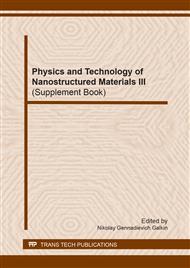[1]
M.S. Dresselhaus, G. Dresselhaus, P.C. Ekland, Science of fullerenes and carbon nanotubes, Academic Press, New York, 1996, 368 p.
Google Scholar
[2]
A.H. Castro Neto, F. Guinea, N.M.R. Peres, K.S. Novoselov, A.K. Geim, The electronic properties of graphene, Rev. Mod. Phys. 81 (2009) 109-162.
DOI: 10.1103/revmodphys.81.109
Google Scholar
[3]
T. Enoki, T. Ando, Physics and chemistry of graphene: graphene to nanographene, Pan Stanford Publishing Pte Ltd., Singapore, 2013, 476 p.
Google Scholar
[4]
H. Marsh, F. Rodriguez-Reinoso, Activated carbon, Elsevier, Amsterdam, 2006, 536 p.
Google Scholar
[5]
B.E. Warren, X-ray diffraction in random layer lattices, Phys. Rev. 59 (1941) 693–698.
DOI: 10.1103/physrev.59.693
Google Scholar
[6]
H. Fujimoto, Theoretical X-ray scattering intensity of carbons with turbostratic stacking and AB stacking structures, Carbon 41 (2003) 1585–1592.
DOI: 10.1016/s0008-6223(03)00116-7
Google Scholar
[7]
K. Kaneko, C. Ishii, M. Ruike, H. Kuwabara, Origin of superhigh surface area and microcrystalline graphitic structures of activated carbons, Carbon 30 (1992) 1075-1088.
DOI: 10.1016/0008-6223(92)90139-n
Google Scholar
[8]
E.A. Smorgonskaya, R.N. Kyutt, V.B. Shuman, A.M. Danishevskii, S.K. Gordeev, A.V. Grechinskaya, Small-angle X-ray scattering in a carbon–sulfur nanocomposite produced from bulk nanoporous carbon, Phys. Solid State 44 (2002) 2001-(2008).
DOI: 10.1134/1.1514795
Google Scholar
[9]
D.I. Svergun, Determination of the regularization parameter in indirect-transform methods using perceptual criteria, J. Appl. Crystallogr. 25 (1992) 495-503.
DOI: 10.1107/s0021889892001663
Google Scholar
[10]
F. Tuinstra, J.L. Koenig, Raman spectrum of graphite, J. Chem. Phys. 53 (1970) 1126-1130.
Google Scholar
[11]
A.C. Ferrari, J. M Robertson, Interpretation of Raman spectra of disordered and amorphous carbon, Phys. Rev. B 61 (2000) 14095-14107.
DOI: 10.1103/physrevb.61.14095
Google Scholar
[12]
R.O. Dillon, J.A. Woollam, V. Katkanant, Use of Raman scattering to investigate disorder and crystallite formation in as-deposited and annealed carbon films, Phys. Rev. B 29 (1984) 3482-3489.
DOI: 10.1103/physrevb.29.3482
Google Scholar
[13]
M.A. Pimenta, G. Dresselhaus, M.S. Dresselhaus, L.G. Cancado, A. Jorio, R. Saito, Studying disorder in graphite-based systems by Raman spectroscopy, Phys. Chem. Chem. Phys. 9 (2007) 1276-1290.
DOI: 10.1039/b613962k
Google Scholar
[14]
J. Weil, J.R. Bolton, Electron paramagnetic resonance: elementary theory and practical applications, Wiley-Interscience, USA, 2007, 664 p.
Google Scholar
[15]
M. Fujita, K. Wakabayashi, K. Nakada, K. Kusakabe, Peculiar localized state at zigzag graphite edge, J. Phys. Soc. Jpn. 65 (1996) 1920-(1923).
DOI: 10.1143/jpsj.65.1920
Google Scholar
[16]
K. Nakada, M. Fujita, G. Dresselhaus, M.S. Dresselhaus, Edge state in graphene ribbons: Nanometer size effect and edge shape dependence, Phys. Rev. B 54 (1996) 17954-17961.
DOI: 10.1103/physrevb.54.17954
Google Scholar
[17]
K. Wakabayashi, M. Fujita, H. Ajiki, M. Sigrist, Electronic and magnetic properties of nanographite ribbons, Phys. Rev. B 59 (1999) 8271-8282.
DOI: 10.1103/physrevb.59.8271
Google Scholar
[18]
J. Tian, H. Cao, W. Wu, Q. Yu, Y.P. Chen, Direct imaging of graphene edges: atomic structure and. electronic scattering, Nano Lett. 11 (2011) 3663-3668.
DOI: 10.1021/nl201590f
Google Scholar
[19]
M. Yamamoto, S. Obata, K. Saiki, Structure and properties of chemically prepared nanographene islands characterized by scanning tunneling microscopy, Surf. Interface Anal. 42 (2010) 1637-1641.
DOI: 10.1002/sia.3583
Google Scholar
[20]
D. Sabramaniam, F. Libisch, Y. Li, C. Pauly, V. Geringer, R. Reiter, T. Mashoff, M. Liebmann, J. Burgdorfer, C. Busse, T. Michely, R. Mazzarello, M. Pratzer, M. Morgenstern, Wave-function mapping of graphene quantum dots with soft confinement, Phys. Rev. Lett. 108 (2012).
DOI: 10.1103/physrevlett.108.046801
Google Scholar
[21]
S.K. Hamalainen, Z. Sun, M.P. Boneschanscher, A. Uppstu, M. Ijas, A. Harju, D. Vanmaekelbergh, P. Liljeroth, Quantum confined electronic states in atomically well-defined graphene nanostructures, Phys. Rev. Lett. 107 (2011) 236803.
DOI: 10.1103/physrevlett.107.236803
Google Scholar
[22]
G.O. Girit, J.C. Meyer, R. Erni, M.D. Rossell, C. Kisielovski, L. Yang, C. -H. Park, M.F. Crommie, M.L. Cohen, S.G. Louie, A. Zettl, Graphene at the edge: stability and dynamics, Science 323 (2009) 1705-1708.
DOI: 10.1126/science.1166999
Google Scholar
[23]
M. Ziatdinov, S. Fujii, K. Kusakabe, M. Kiguchi, T. Mori, T. Enoki, Visualization of electronic states on atomically smooth graphitic edges with different types of hydrogen termination, Phys. Rev. B 87 (2013) 115427.
DOI: 10.1103/physrevb.87.115427
Google Scholar
[24]
S. Fujii, M. Ziatdinov, K. Kusakabe, M. Kiguchi, T. Enoki, Role of edge geometry and chemistry in the electronic properties of graphene nanostructures, Faraday Discuss. 173 (2014) 173-199.
DOI: 10.1039/c4fd00073k
Google Scholar


